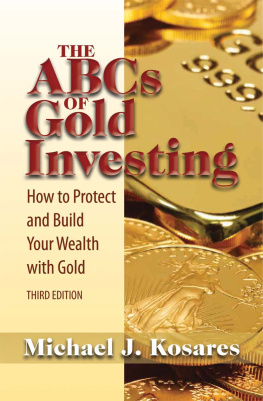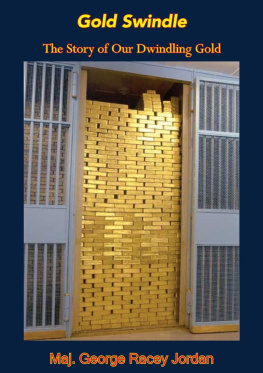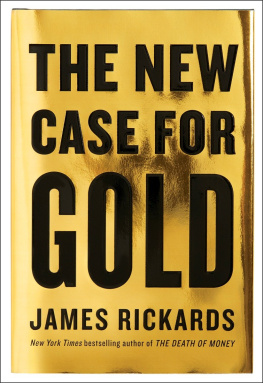
An Addicus Nonfiction Book
Copyright 2013 by Michael Kosares. All rights reserved. No part of this publication may be reproduced, stored in a retrieval system, or transmitted in any form or by any means, electronic, mechanical, photocopied, recorded, or otherwise, without the prior written permission of the publisher. For information, write Addicus Books, Inc., P.O. Box 45327, Omaha, Nebraska 68145.
ISBN 978-1-936374-83-0
This book is made available with the understanding that it has been prepared for informational purposes only and the Publisher and Author are not engaged in rendering legal, accounting, financial, investment, or other professional services. The information in this book is not intended to create, and the reading of it does not constitute a lawyer-client relationship, accountant-client relationship, investment advisor-client relationship, or any other type of relationship. If legal, financial, or investment advice or other expert assistance is required, the services of a competent professional person should be sought. The Publisher and Author disclaims all warranties and any personal liability, loss, or risk incurred as a consequence of the use and application, either directly or indirectly, of any information presented herein.
Library of Congress Cataloging-in-Publication Data
Kosares, Michael J., 1948
The ABCs of gold investing : how to protect and build your wealth with gold / Michael J. Kosares. 3rd ed.
p. cm. (An Addicus nonfiction book)
Includes bibliographical references and index.
ISBN 978-1-936374-83-0 (alk. paper)
1. Gold--Purchasing--United States. 2. InvestmentsUnited States. I. Title.
HG295.U6K67 2012
332.63--dc22
2012023270
Addicus Books, Inc.
P.O. Box 45327
Omaha, Nebraska 68145
www.AddicusBooks.com
Printed in the United States of America
10 9 8 7 6 5 4 3 2 1
Contents
To the true believers whose staunch advocacy laid the foundation for the contemporary gold market
Acknowledgments
T he following organizations played an instrumental role in bringing this book to fruition: Gold Fields Mineral Services, Ltd. of London, England; the World Gold Council of New York; the St. Louis Federal Reserve Bank; the Gold Institute; the United States Mint; the Austrian Mint; the Royal Canadian Mint; the Gold Corporation of Australia; the South African Chamber of Mines; the American Numismatic Association; and the Mexican Consulate in Denver, Colorado, U.S.
For their prompt and complete support, I owe these organizations a huge debt of gratitude. Last but not least, I would like to thank Dr. Henry Swenson, who gave me the idea for this book in the first place. Without them, The ABCs of Gold Investing would have remained an unrealized dream.
Introduction
T his book is a distillation of nearly forty years experience working with private investors interested in adding gold to their investment portfolios. For many years, investors looking for a how-to guide on private gold ownership have gone home from the bookstore empty handed. With the publication of this guideline, a basic who, what, when, where, why, and how of private gold ownership is now available.
At the outset, I would like to make it clear that the purpose of this book is not to offer a proposed solution to the current economic problem now gripping the United States, Europe, and other nations around the globe. Insofar as it examines these problems, my intent is to explain their connection to the growing demand for gold in coin and bullion form. At the same time, anyone who reads the financial section of the morning newspaper and does not come away with a sense of unease should question whether or not he or she is processing the information correctly. A sense of anxiety, it would seem to me, comprises the rational response. Though we live in an age of gold, given its nearly ten-year bull market, it has not been in any sense a golden age.
It is to allay this sense of anxiety that so many, over the past decade and particularly over the past five years, have opted to diversify their portfolios with gold. Investment demand has reached a record level, as has demand from financial institutions, like hedge and pension funds, and lately from central banks. In the process, the gold price has steadily advanced on world markets to record highs. Over the past decade, the primary motivations for gold ownership have been asset preservation and wealth building as stock markets around the world went into a tailspin, yields trended toward zero, and confidence in the long-term purchasing of the dollar began to erode.
Now a new motivation for gold ownership has entered the market, one rooted in a dynamic shift in golds supply-demand fundamentals. There is a sense of change in what is required in the modern investment portfolio to counter economic uncertainties over the long term. Gold, as the ultimate architect and protector of wealth, has recaptured its place as a permanent fixture in the asset portfolio, both public and private. This important change in sentiment strongly suggests the possibility of steady to increasing demand in the years to come as more and more investors come to view gold as a permanent, or semipermanent, portfolio fixture and a long-term savings alternative.
For many, this book could not have come at a better time. You now have in your hands a practical and comprehensive how-to manual for making an informed decision about gold ownership. Perhaps gold can offer you what it has offered countless others over the centuries: solid, unassailable protection against the gathering storm.
Michael J. Kosares Denver,
Colorado
2012
Indeed, there can be no other criterion, no other standard, than gold. Yes, gold, which never changes, which can be shaped into ingots, bars, coins, which has no nationality and which is eternally and universally accepted as the unalterable fiduciary value par excellence.
Charles DeGaulle
Chapter 1
A is for
Asset Preservation:
Why Americans Need Gold
The possession of gold has ruined fewer men than the lack of it.
Thomas Bailey Aldrich
T he incident is one of the most memorable of my career. Never before or since has the value of gold in preserving assets been made so abundantly clear to me. It was the mid-1970s. The United States was finally extricating itself from the conflict in South Vietnam. Thousands of South Vietnamese had fled their embattled homeland rather than face the vengeance of the rapidly advancing Communist forces.
A couple from South Vietnam who had been part of that exodus sat across from me in my Denver office. They had come to sell their gold. In broken English, the man told me the story of how he and his wife had escaped the fall of Saigon and certain reprisal by North Vietnamese troops. They got out with nothing more than a few personal belongings and the small cache of gold he now spread before me on my desk. His eyes widened as he explained why they were lucky to have survived those last fearful days of the South Vietnamese Republic. They had scrambled onto a fishing boat and had sailed into the South China Sea, where the U.S. Navy rescued them. These were Vietnamese boat people, survivors of the final chapter in the tragedy of Indochina. Now they were about to redeem their life savings in gold so that they could start a new business in the United States.

Next page








